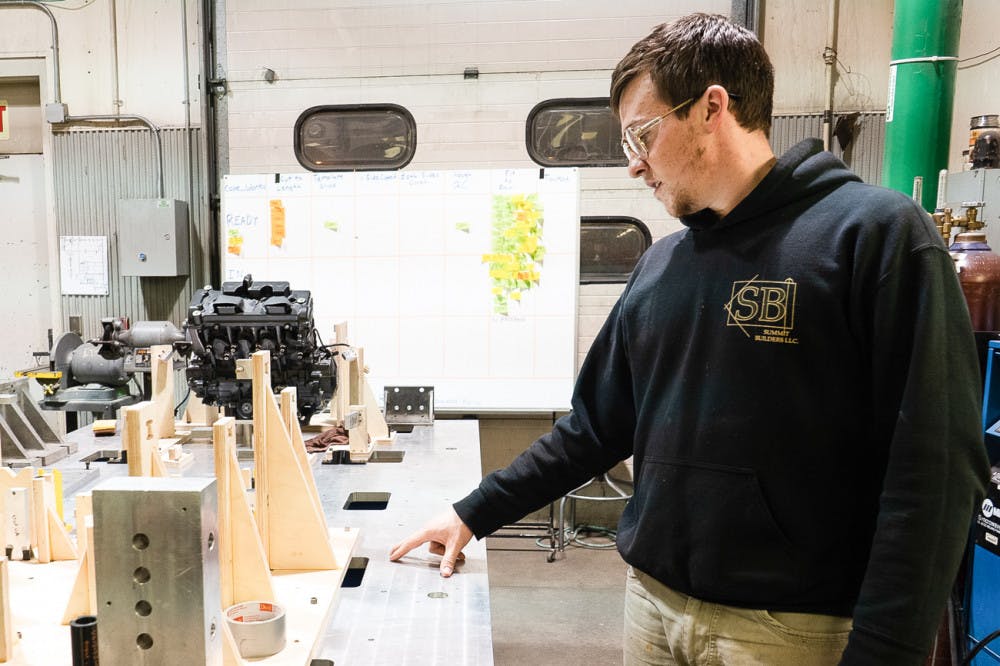Photo by Max Gleiberman
By John Olson
The WWU Racing team has been building Formula style cars since 1989, but to them, racing is more about building the right team.
From English to engineering majors, anywhere from 20 to 60 students dedicate their entire year to building a car fit to compete against 80 other schools in one of two Formula SAE competitions held in the United States.
Students are responsible for the production of the car from start to finish. They design everything from the chassis, suspension, powertrain, ergonomics and electronics, all while maintaining a comprehensive and practical business plan, fifth-year Harley Kyger, WWU Racing project manager, said.
It’s obvious to both outsiders and members on the team that building the car isn’t the priority, it’s the people.
“You build an A-team before you build an A-car,” Kyger said. “What gets me excited is the atmosphere of being on the team working together on this project. We really have no limitations.”
Third-year Henry Millican, powertrain system lead, joined WWU Racing three years ago after transferring from Seattle University to major in manufacturing and engineering.
“Formula SAE is a great way to apply your education. No matter what your major is, it’s really just an awesome team building experience,” Millican said. “It really prepares you for the workplace, no matter what job you have, because you have to work closely with people as a team.”
Kyger also said there’s no limitation on who can apply to be a part of the team. The WWU Racing website states the only requirement is a willingness and dedication to learn.
“You can have a group of students that have never touched a car before build their own race car, and go to a competition across the United State and finish top 10,” Kyger said. “We can teach students who have never used a tool before how to use them.”
Kyger said their members can spend anywhere from five to 40 hours a week in the shop, most of them pursuing this passion on top of school, homework and a job.
“Sometimes I’m working with people to teach them computer-aided design, or how to use hand tools, then some days I’m out in the machine shop,” Millican said. “There has been no faster time than the time I spend [working toward] Formula SAE.”
Kyger laid out the timeline for WWU Racing: their season begins in the summer with a small group of students starting extensive research and evaluations of the previous years' designs. Then the car comes together piece by piece over fall and winter quarter. It starts with the designing phase in early fall with the creation of 3D models for all the various parts and components - this years car, “Viking 61,” contains about 1,200 modeled pieces, according to Kyger.
“A lot of people ask where we buy our car, [but] we make 90 percent [of it]. Pretty much anything we can make, we will make,” fifth-year Riley Dickinson, technical director, said.

In winter quarter, students begin the in-house manufacturing of the modeled pieces, Kyger said. Assembly begins halfway through March, with the car needing to be driveable by April.
“[Winter] quarter started out a little slow, but over the last few days, things have been ramping up and people are getting involved. There’s a really energetic atmosphere, and it’s definitely contagious,” Kyger said.
Working in tandem, the business side of WWU Racing handles everything from budgets, sourcing and securing sponsorships, Kyger said.
“We run like a business. It’s how we’re successful. Although there is a lot of engineering work, without the business side of the team it would be incredibly difficult,” Kyger said. “[These students] create the budget, do all the purchasing, cost [out] events and more.”
Outside of helping to keep the engineering team funded, the business team’s responsibility is the Formula SAE business presentation. According to the society’s rules, students try to appeal to corporation executives with a design that is profitable to manufacture and is marketable to amateurs. Students are asked to justify every design and manufacturing decision alongside presenting their finances and comprehensive marketing strategy.
The next step for WWU Racing starts in spring quarter when they will test their assembled car. Kyger said that almost every Sunday, the team runs tests at the Bellingham Airport for about 12 hours. Kyger said that every test gives them more information on what they need to improve and tune.
Finally, in June, the team will compete in Formula SAE in Lincoln, Nebraska. Their car is tested in various events like acceleration, skid pad, autocross and endurance. According to Dickinson, University of Washington and Washington State University are the only other Washington schools that compete at this level.
“It’s one of the most unique projects you can do,” Dickinson said. “You get out of it what you put in. There’s really no limit to that.”
WWU Racing meets 6:30 p.m. most Mondays in Artzen Hall in room 100, where they go over general information including where they are in the project, and where they’re heading. Those interested in joining are recommended to come to these meetings and can check the WWU Racing Facebook page for more information.





